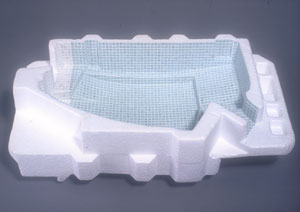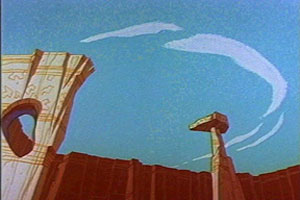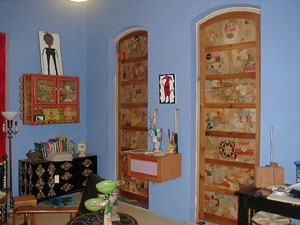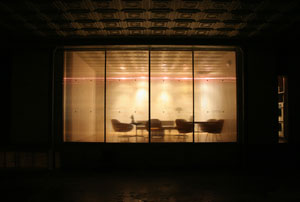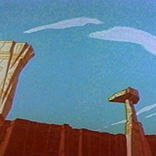This is the second of a two-part series about the commercial building craze in San Antonio’s art community.
This is the second of a two-part series about the commercial building craze in San Antonio’s art community. Despite being one of the largest cities in America (its population is already estimated to be larger than that of Dallas), San Antonio’s low per capita income and affordable housing makes it possible for art types to carve out a comfortable life.
Unoccupied vintage buildings, a scarce commodity in larger cities, are still plentiful in San Antonio. These structures have many attractive features for artists — perfect for messy studio work, they can be vast, inexpensive, remodeled to suit; and they exude a pleasing aura of artist-as-laborer (think Jackson Pollock in his coveralls). That said, it takes more creativity, grit, and elbow grease to make something special out of an unwanted old building than people ever realize when they see the finished product.
For nearly twenty years, artist Danville Chadbourne has been working in a turn-of-the-century grocery store on the corner of West Summit and Grant Avenue. He has been told the store was once the end of a former trolley line. Today, the original wood frame is disguised by a faux-stone façade affixed in the 1960s, when the building was Zimmerman’s Grocery Store and Chadbourne was a college art student hoping to avoid the Vietnam War.
The store was abandoned by the time Chadbourne took a studio space there in 1985 for $150 a month. Three artists had renovated it and created individual spaces the year before and, as each moved out, Chadbourne absorbed their areas until he had the whole building to himself.
On the outside, the building is indistinguishable from other corner buildings. Walking in, however, you are confronted with a dense forest of tall, anthropomorphic sculptures. Square wall pieces climb towards the ceiling and color vies with rich wood grain in a sea of shapes everywhere you look.
Chadbourne desperately needs space — lots of it — because his range of media is broad: clay, stone, wood, paint, and bronze. Each requires its own specialized disarray. Looking down the long, narrow room, which has a wood shop running alongside, you see the adjoined area where Chadbourne glazes and fires his sculptural ceramic elements. This room leads outside into the amazing backyard garden that extends into the next yard. Chadbourne and his partner Diana Lyn Roberts (who, until its recent closure, was director of San Antonio’s Center for Spirituality and the Arts) were able to pay off the building in a short time. They have since purchased the house next door, which is also completely filled with pedestals, extra work spaces, and Roberts’ office. The backyards have merged, with the kiln area spilling out behind the former grocery store and concrete mixing area settled behind the house. These areas have taken over, while their apartment living area in the back, completely built on $2500, is a no-frills storage unit for huge quantities of books and music, as well as a place to prepare food from their own garden. They could be described as hippies, but they seem more like explorers, interested in recreating the smells, flavors, and textures of life.
While Chadbourne and Roberts’ grocery store home is deceptively tame on the outside, for artists Rhonda Kuhlman and Chris Ake, the more colorful the better. Kuhlman is a consummate traveler who studied art and art history in Los Angeles, Houston, New York, London, and East Texas, is still amazed to have “bought dirt” in Texas. Together, she and Ake, a ceramicist by training, combine their interests in folk and outsider art with an appreciation of roadside Americana. Ake’s object making fit perfectly with Kuhlman’s own jewelry and craft habit, and the pair has turned their objects into a cottage industry.
In the mid-90s, Kuhlman and Ake’s Coke-can Christmas ornaments and bottle cap jewelry were particularly sought after in their then-home of Portland, Oregon where recycling and crafts are both part of the mainstream. Kuhlman was known as the lady on the corner who bought recyclables in bulk from the homeless. Priced out by the housing market, they moved to Austin in 1997 and shortly afterward visited Nate Cassie’s ArtPace opening, got hooked on the city to the south, and packed up.
They buy their collectible vintage bottle caps from various antique dealers — particularly the mint-condition cork-backed caps that were replaced by plastic seals in the 1960s. Chris also reworks reclaimed vintage furniture, decorating pieces with soda caps and retro labels to accentuate the patina of nostalgia. Their company, Recycled Works, is now a thriving wholesale business that the British and Japanese particularly love.
Their first space in San Antonio, at the end of the Blue Star Complex, was big enough to display art in addition to their wares, so they started the well-loved RC Gallery, so named for the classic soda as well as their own first initials. Kuhlman says their regular commercial business was a good way to coax lost and slightly terrified tourists into looking at art as well.
Eventually, the lease on the Southtown house where they lived was up, and they felt it was time for a change in business as well. The First Friday art scene at Blue Star had become too much to handle, along with the responsibility of keeping hundreds of people in toilet paper and beer. They were ready to reconsolidate business and home, and give up the regular hours of retail. So they went looking for a building.
They found the Old Richie Electric Building, built around 1910 near Roosevelt Park. When the couple saw it, it had been empty for a good 30 years. It had no roof, floor, electricity, plumbing, or front wall — but the colorful, art moderne building on a big corner lot was too good to ignore. One day they knocked on the door and found the owner inside, stripping it to its bones and recycling the components. It was not’t for sale but he was intrigued enough to show up one day during Christmas season at their Blue Star shop and seemed to realize their aesthetic and industriousness would fit the building. They negotiated a price and the couple, after taking on additional outside jobs and dealing with months of red tape, purchased it and moved in.
The building had been brought up to code and given a floor, but it still only had one toilet and one tiny sink. The couple rented a Porto-let and joined the YMCA to take Village People-esque showers. As it turned out, their building had never been hooked up to the city sewer line. Instead, they were the proud owners of a very crudely built cesspool that fills up in the rain. In their words, this was IT: this was the Big Thing that would go wrong. Ake ran pipes all along the inside of the building to direct water to a big, new sink in the bathroom. Letting their gym memberships lapse, the couple showered in the backyard for six months with no hot water.
Inside, Robert Diaz de Leon, a friend and artisan-quality blacksmith, made a deluxe screen door for the street entrance while art furniture designer Peter Zubiate built them two nine-feet tall swinging doors for the bedroom. Ake, an avid album collector, lacquered vintage album sleeves on the doors in a faded collage.
They had their first art show in the summer of 2004, in time for Contemporary Art Month. Wanting to challenge their friends with a deceptively difficult folk tradition, they hosted a whirligig show in their back yard. Artists could make anything they wanted as long as it could sit outside for a month and blow in the wind. Approximately 25 artists submitted works, some more successful at turning than others. The bizarre array of colorful objects chugging along in the front and back yards, as well as on the roof, made Ake and Kuhlman the wonder of the neighborhood.
The new RC Gallery has had two shows since then, in its new front gallery space. Ake and Kuhlman like that they can adapt the building to whatever they’re doing. Right now, Recycled Works is strictly wholesale, and the couple travels to trade fairs nationwide. Meanwhile, Rhonda lines their garden beds with pop bottles and their outside walls with folk art, while Ake just opened a solo show at San Angel Folk Art, featuring intricate paintings out of cut soda cans and cookie tins. Their wondrous estate is flanked by two huge, rusted electrical drill bits.
If you head north on South Presa from Chris and Rhonda’s place, in no time you’ll come to Tortilleria La Popular, home of artists Jennifer Davy and Guy Hundere.
Like Ake and Kuhlman, Hundere and Davy spent the mid-90s living on the West Coast. They met in 1995 while working at Zombie Studios, a virtual reality game company in Seattle. Soon, Davy left Seattle to attend the San Francisco Art Institute and Hundere left to explore South America.
On his return, Hundere moved into Davy’s San Francisco apartment, a small, rent-controlled place with passive-aggressive hippie roommates. The two often went apartment hunting, but it was the height of the dot com days. One day a friend of Hundere’s telephoned and said he was living on a beautiful sheep farm near Fredericksburg, TX and would Guy like to move there and rent it for $450 a month? The couple took it sight unseen, planning to turn the adjacent barn into a studio. Davy had just been offered a partnership at Refusalon Gallery, but she passed it up. The couple was thinking next stop wonderland.
But when Davy arrived a few months after Hundere and he picked her up at the Austin airport, they continued to turn off onto more and more desolate roads, marked by a single desolate power line. She knew there was a problem.
The barn in which they hoped to make art turned out to be a cinder block shed infested with wasps and currently storing someone else’s belongings. They could not’t get a proper internet connection, which crippled Guy’s digital programming work. The house was a shanty and the bathtub, which used to be the pig trough, had trails of insects running up the pipe daily. The sheep were suffering under three years of uncut wool and dropping off one by one, often in their driveway, and they had to burry them in rock hard earth. Clearly, they were not’t going to get much work done out there.
Ten months later, Hundere’s grandmother in San Antonio wanted the couple to move into her unoccupied home on West Mistletoe. Originally, their plan had been to buy a commercial building that could serve all of the purposes the sheep farm was ideally to have, minus the sprawling vista and dead sheep. So, while renovating the Mistletoe house, they continued looking.
Tortilleria La Popular had windows so filthy, you couldn’t see the “For Sale” sign behind them. Guy found it on a website and, because no one realized it was available, everyone was shocked at their luck. Built in the 1910s, the building was originally an arcade amusement center, which went through a variety of tenants, the last one being the La Popular tortilla factory.
Walking into the building was like walking into Pompeii and seeing bread still in the ovens. Hundere and Davy describe a scene that looked like everyone just got up and walked out one day and never came back — half-full cups of coffee on desks, cigarettes in ashtrays, fly fishing photos on the wall and gear in the closet. Once the couple bought the place, the owners cleared it out, except for a desk that, when examined, still had the legendary tortilla recipe taped secretively to the inside. Even with the equipment cleared out, the tortillas left their gooey calling card in the form of a lard-caked tin ceiling.
The first thing they did was get a Main Street Alliance “Operation Facelift” grant that gives money to fix facades and improve the visual appeal of neighborhoods. They got artist Rae Culbert, a carpenter and contractor by day, to build cedar storefront windows, inspired by Donald Judd’s use of cedar at Chinati and the aged cedar of San Antonio’s missions, along two sides of the building. They also repaired the roof before the money ran out.
For a while, a number of factors halted the building’s progress, and artist Kim Squaglia used the empty space as her studio (most of the work in her February 2002 show at Finesilver Gallery came out of her sojourn in the tortilla factory). In October 2002, Davy and Hundere also hosted the Sala Gala, a fundraiser for Sala Diaz art space, so their building was still fulfilling a function in the art scene, despite standing empty.
In 2003 work began again, and Hundere’s brother, local architect Davis Sprinkle, helped them arrive at a workable design for an interior living space. That summer, the couple was also temporarily homeless, having rented out their house, so they moved into a short, but very cool vintage trailer parked inside the building. They put a tarp bubble around the entrance for a few extra square feet of dust-free space. It was essentially an urban igloo in the middle of a tortilla factory.
The nearly-completed design of their 1,000 square feet of living space is remarkably like a raised Japanese house with sliding doors, beautiful materials, and even a Japanese soaking tub. It divides the factory lengthwise and is elevated to reduce the volume of space needing climate control. The couple’s living area is filled with vintage Danish Modern sitting arrangements in orange and white — Hundere traded web design for the furniture in a shrewd barter. The wall behind them is the original wall, sandblasted into a beautiful abstract surface design.
Their home-within-a-home cuts the factory essentially down the middle, leaving a long expanse of open area that can be put to many future uses. Originally, Hundere and Davy imagined various art exhibitions taking place, but now that the work is finished, they have little or no wall space. They envision sculpture and installation shows now, as well as readings, film series, musical theater, and dance performances. While the couple plans to be organic about planning (meaning not being pinned down to a densely-packed exhibition schedule) they are looking forward to taking show proposals. The first show, of Davy’s sculptural photographs, is slated to take place in September 2005.
In the meantime, work continues on the space which is itself organic. Construction is finishing on an office for Jennifer with a huge picture window and floor-to-ceiling shelves. The back part of the factory holds their wood shop and studio space for working with messier materials, while the walls are crawling with interesting objects and heirlooms, including Hundere’s bicycle history. They simply open the loading door to let the dust out and the light in.
Stories like these are abundant. Ken Little’s studio warehouse alone could be an entire feature. Riley Robinson lives and works in a Southtown warehouse he purchased from Little. The Bower, a gallery and living space co-directed by Joey Fauerso, Michael Velliquette, and Leslee Fraser, closed its St. Mary’s Street doors this summer but may sprout up again soon in another form. The list goes on an on. All of these artists are recreating the ideal of the house with a white picket fence into something that functions within the industrial vernacular. If you imagine all of these commercial buildings side by side, it seems that an art Gotham is on the rise, and without the need for urban sprawl.



